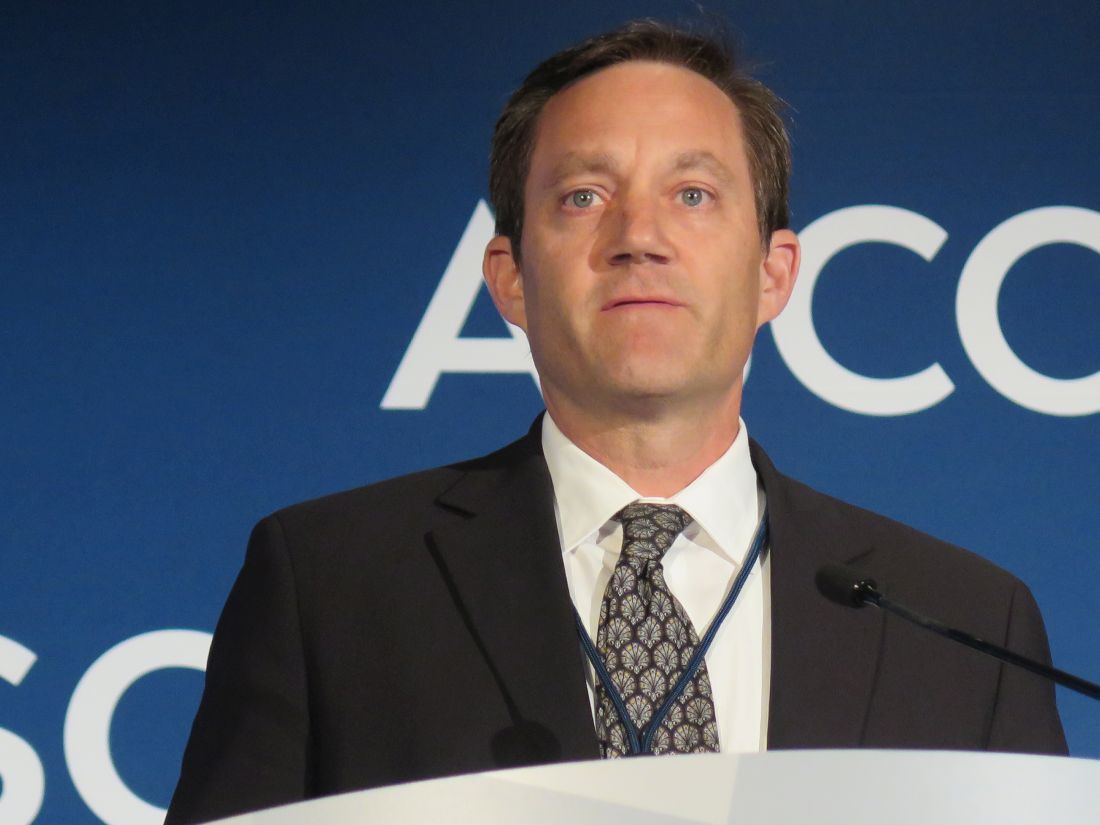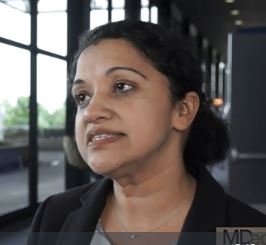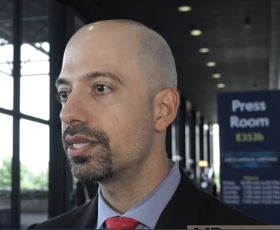User login
Atezolizumab has PFS benefit in first-line squamous NSCLC
CHICAGO – Adding the immune checkpoint inhibitor atezolizumab (Tecentriq) to first-line chemotherapy for squamous non–small cell lung cancer (NSCLC) improves outcomes, according to results of the IMpower131 trial reported at the annual meeting of the American Society of Clinical Oncology.
“Squamous NSCLC remains a very difficult to treat disease, and there have been very limited new treatment options presented to us over the last few decades,” lead study author Robert M. Jotte, MD, PhD, medical director and co-chair, USON Thoracic Committee, Rocky Mountain Cancer Centers in Denver, said in a press briefing. Chemotherapy is still considered standard of care in the first-line setting.
Main results showed that compared with chemotherapy (carboplatin and nab-paclitaxel) alone, the combination of atezolizumab and chemotherapy reduced the risk of progression-free survival events by 29%, prolonging median time to an event by about a month. Findings were similar regardless of the level of PD-L1 positivity, although reduction in events was greatest for patients whose tumors were highly positive.
Median overall survival was about 14 months in each arm, with no significant difference, although results are not yet mature.
“IMpower131 data show that patients with advanced squamous NSCLC benefit more from initial treatment with atezolizumab plus chemotherapy than from chemotherapy alone,” Dr. Jotte summarized. The combination “has a manageable safety profile consistent with known safety risks of the individual therapies, with no new safety signals identified.”
The investigators are continuing to follow overall survival, with the next interim analysis expected to occur later this year. “In the IMpower131 study, patients were not allowed to cross over. However, among patients who were monitored and followed for subsequent therapy, nearly half went on to receive immuno-oncologic therapies beyond the study, so that will likely taint the overall survival curves,” he noted.
Patients receiving chemotherapy for advanced lung cancer are devastated when told that their disease has progressed, he commented. “What we see with the results of this study is that we can actually double the chance that they don’t have to hear that bad news in the first year of treatment.”
“We hope that the results seen with progression-free survival translate to improved overall survival. If and when that is shown, I think we will clearly have a new standard of care for the front-line treatment of squamous cell NSCLC,” concluded Dr. Graham, who is also medical director at the Levine Cancer Institute in Charlotte, N.C.
Study details
With a median follow-up of 17.1 months in IMpower131, median progression-free survival was 5.6 months with chemotherapy alone and 6.3 months when atezolizumab was added to chemotherapy (hazard ratio, 0.71; P = .0001).
There was a doubling of the 12-month progression-free survival rate, from 12.0% to 24.7%, Dr. Jotte reported.
Atezolizumab improved progression-free survival across levels of PD-L1 expression, but benefit was most pronounced in patients with tumors having a high level of this biomarker (hazard ratio, 0.44).
Findings were similar for response, with a higher overall response rate seen with atezolizumab plus chemotherapy versus chemotherapy alone (49% vs. 41%) and greatest difference in the subgroup whose tumors were highly PD-L1 positive (60% vs. 33%). Median duration of response was 7.2 months with the immunotherapy and 5.2 months without it.
Interim overall survival results showed that patients lived a median of 14.0 months with atezolizumab plus chemotherapy and 13.9 months with chemotherapy alone (hazard ratio, 0.96; P = .6931).
Data from a third arm of the IMpower131 trial, in which atezolizumab was added to carboplatin plus paclitaxel, have not reached a point where statistical analyses can be done, according to Dr. Jotte.
A related phase 3 trial, IMpower150, is testing addition of atezolizumab to chemotherapy, with or without bevacizumab, as first-line therapy for metastatic nonsquamous NSCLC. Investigators will be reporting results at the meeting for both overall survival (abstract 9002) and patient-reported outcomes (abstract 9047).
Dr. Jotte disclosed that he is on the speakers’ bureau for Bristol-Myers Squibb, and that he receives travel, accommodations, and/or expenses, as well as honoraria from Bristol-Myers Squibb. The study received funding from F. Hoffmann-La Roche Ltd.
SOURCE: Jotte et al. ASCO 2018 Abstract LBA9000.
CHICAGO – Adding the immune checkpoint inhibitor atezolizumab (Tecentriq) to first-line chemotherapy for squamous non–small cell lung cancer (NSCLC) improves outcomes, according to results of the IMpower131 trial reported at the annual meeting of the American Society of Clinical Oncology.
“Squamous NSCLC remains a very difficult to treat disease, and there have been very limited new treatment options presented to us over the last few decades,” lead study author Robert M. Jotte, MD, PhD, medical director and co-chair, USON Thoracic Committee, Rocky Mountain Cancer Centers in Denver, said in a press briefing. Chemotherapy is still considered standard of care in the first-line setting.
Main results showed that compared with chemotherapy (carboplatin and nab-paclitaxel) alone, the combination of atezolizumab and chemotherapy reduced the risk of progression-free survival events by 29%, prolonging median time to an event by about a month. Findings were similar regardless of the level of PD-L1 positivity, although reduction in events was greatest for patients whose tumors were highly positive.
Median overall survival was about 14 months in each arm, with no significant difference, although results are not yet mature.
“IMpower131 data show that patients with advanced squamous NSCLC benefit more from initial treatment with atezolizumab plus chemotherapy than from chemotherapy alone,” Dr. Jotte summarized. The combination “has a manageable safety profile consistent with known safety risks of the individual therapies, with no new safety signals identified.”
The investigators are continuing to follow overall survival, with the next interim analysis expected to occur later this year. “In the IMpower131 study, patients were not allowed to cross over. However, among patients who were monitored and followed for subsequent therapy, nearly half went on to receive immuno-oncologic therapies beyond the study, so that will likely taint the overall survival curves,” he noted.
Patients receiving chemotherapy for advanced lung cancer are devastated when told that their disease has progressed, he commented. “What we see with the results of this study is that we can actually double the chance that they don’t have to hear that bad news in the first year of treatment.”
“We hope that the results seen with progression-free survival translate to improved overall survival. If and when that is shown, I think we will clearly have a new standard of care for the front-line treatment of squamous cell NSCLC,” concluded Dr. Graham, who is also medical director at the Levine Cancer Institute in Charlotte, N.C.
Study details
With a median follow-up of 17.1 months in IMpower131, median progression-free survival was 5.6 months with chemotherapy alone and 6.3 months when atezolizumab was added to chemotherapy (hazard ratio, 0.71; P = .0001).
There was a doubling of the 12-month progression-free survival rate, from 12.0% to 24.7%, Dr. Jotte reported.
Atezolizumab improved progression-free survival across levels of PD-L1 expression, but benefit was most pronounced in patients with tumors having a high level of this biomarker (hazard ratio, 0.44).
Findings were similar for response, with a higher overall response rate seen with atezolizumab plus chemotherapy versus chemotherapy alone (49% vs. 41%) and greatest difference in the subgroup whose tumors were highly PD-L1 positive (60% vs. 33%). Median duration of response was 7.2 months with the immunotherapy and 5.2 months without it.
Interim overall survival results showed that patients lived a median of 14.0 months with atezolizumab plus chemotherapy and 13.9 months with chemotherapy alone (hazard ratio, 0.96; P = .6931).
Data from a third arm of the IMpower131 trial, in which atezolizumab was added to carboplatin plus paclitaxel, have not reached a point where statistical analyses can be done, according to Dr. Jotte.
A related phase 3 trial, IMpower150, is testing addition of atezolizumab to chemotherapy, with or without bevacizumab, as first-line therapy for metastatic nonsquamous NSCLC. Investigators will be reporting results at the meeting for both overall survival (abstract 9002) and patient-reported outcomes (abstract 9047).
Dr. Jotte disclosed that he is on the speakers’ bureau for Bristol-Myers Squibb, and that he receives travel, accommodations, and/or expenses, as well as honoraria from Bristol-Myers Squibb. The study received funding from F. Hoffmann-La Roche Ltd.
SOURCE: Jotte et al. ASCO 2018 Abstract LBA9000.
CHICAGO – Adding the immune checkpoint inhibitor atezolizumab (Tecentriq) to first-line chemotherapy for squamous non–small cell lung cancer (NSCLC) improves outcomes, according to results of the IMpower131 trial reported at the annual meeting of the American Society of Clinical Oncology.
“Squamous NSCLC remains a very difficult to treat disease, and there have been very limited new treatment options presented to us over the last few decades,” lead study author Robert M. Jotte, MD, PhD, medical director and co-chair, USON Thoracic Committee, Rocky Mountain Cancer Centers in Denver, said in a press briefing. Chemotherapy is still considered standard of care in the first-line setting.
Main results showed that compared with chemotherapy (carboplatin and nab-paclitaxel) alone, the combination of atezolizumab and chemotherapy reduced the risk of progression-free survival events by 29%, prolonging median time to an event by about a month. Findings were similar regardless of the level of PD-L1 positivity, although reduction in events was greatest for patients whose tumors were highly positive.
Median overall survival was about 14 months in each arm, with no significant difference, although results are not yet mature.
“IMpower131 data show that patients with advanced squamous NSCLC benefit more from initial treatment with atezolizumab plus chemotherapy than from chemotherapy alone,” Dr. Jotte summarized. The combination “has a manageable safety profile consistent with known safety risks of the individual therapies, with no new safety signals identified.”
The investigators are continuing to follow overall survival, with the next interim analysis expected to occur later this year. “In the IMpower131 study, patients were not allowed to cross over. However, among patients who were monitored and followed for subsequent therapy, nearly half went on to receive immuno-oncologic therapies beyond the study, so that will likely taint the overall survival curves,” he noted.
Patients receiving chemotherapy for advanced lung cancer are devastated when told that their disease has progressed, he commented. “What we see with the results of this study is that we can actually double the chance that they don’t have to hear that bad news in the first year of treatment.”
“We hope that the results seen with progression-free survival translate to improved overall survival. If and when that is shown, I think we will clearly have a new standard of care for the front-line treatment of squamous cell NSCLC,” concluded Dr. Graham, who is also medical director at the Levine Cancer Institute in Charlotte, N.C.
Study details
With a median follow-up of 17.1 months in IMpower131, median progression-free survival was 5.6 months with chemotherapy alone and 6.3 months when atezolizumab was added to chemotherapy (hazard ratio, 0.71; P = .0001).
There was a doubling of the 12-month progression-free survival rate, from 12.0% to 24.7%, Dr. Jotte reported.
Atezolizumab improved progression-free survival across levels of PD-L1 expression, but benefit was most pronounced in patients with tumors having a high level of this biomarker (hazard ratio, 0.44).
Findings were similar for response, with a higher overall response rate seen with atezolizumab plus chemotherapy versus chemotherapy alone (49% vs. 41%) and greatest difference in the subgroup whose tumors were highly PD-L1 positive (60% vs. 33%). Median duration of response was 7.2 months with the immunotherapy and 5.2 months without it.
Interim overall survival results showed that patients lived a median of 14.0 months with atezolizumab plus chemotherapy and 13.9 months with chemotherapy alone (hazard ratio, 0.96; P = .6931).
Data from a third arm of the IMpower131 trial, in which atezolizumab was added to carboplatin plus paclitaxel, have not reached a point where statistical analyses can be done, according to Dr. Jotte.
A related phase 3 trial, IMpower150, is testing addition of atezolizumab to chemotherapy, with or without bevacizumab, as first-line therapy for metastatic nonsquamous NSCLC. Investigators will be reporting results at the meeting for both overall survival (abstract 9002) and patient-reported outcomes (abstract 9047).
Dr. Jotte disclosed that he is on the speakers’ bureau for Bristol-Myers Squibb, and that he receives travel, accommodations, and/or expenses, as well as honoraria from Bristol-Myers Squibb. The study received funding from F. Hoffmann-La Roche Ltd.
SOURCE: Jotte et al. ASCO 2018 Abstract LBA9000.
REPORTING FROM ASCO 2018
Key clinical point: .
Major finding: Compared with chemotherapy alone, chemotherapy plus atezolizumab prolonged median progression-free survival from 5.6 to 6.3 months (hazard ratio, 0.71; P = .0001).
Study details: A phase 3 randomized, controlled trial among 1,021 all-comer (PD-L1–unselected), chemotherapy-naïve patients with stage IV squamous NSCLC (IMpower131 trial).
Disclosures: Dr. Jotte disclosed that he is on the speakers’ bureau for Bristol-Myers Squibb, and that he receives travel, accommodations, and/or expenses, as well as honoraria from Bristol-Myers Squibb. The study received funding from F. Hoffmann-La Roche Ltd.
Source: Jotte et al. ASCO 2018 Abstract LBA9000.
Ivosidenib leads to complete responses in 32% of IDH1-mutated relapsed/refractory AML
CHICAGO – The investigational drug ivosidenib was associated with durable responses, transfusion independence, and a low rate of serious adverse events in patients with IDH1-mutated relapsed/refractory acute myeloid leukemia (AML), based on results of a phase 1 study presented at the annual meeting of the American Society of Clinical Oncology (ASCO).
Daily oral ivosidenib, which inhibits mutant IDH1 the gene that encodes for isocitrate dehydrogenase 1 and is present in 6%-10% of AML patients, was associated with a complete response rate of nearly 32%. In patients who achieved a complete response, median duration of response was 8.2 months and median overall survival was 18.8 months, Daniel A. Pollyea, MD, University of Colorado School of Medicine, Aurora, reported at the meeting.
A wide variety of study participants achieved transfusion independence, even patients who had lesser and no discernable responses, Dr. Pollyea said. “A significant minority of these patients (with lesser or no response) were able to achieve transfusion independence which is obviously a big achievement with respect to quality of life, and suggestive of the mechanism of action here with respect to differentiation.”
The conclusions of this study are “striking,” with response rates and tolerability “very similar” to results seen with the IDH2 inhibitor enasidenib, said Eunice S. Wang, MD, of Roswell Park Comprehensive Cancer Center, Buffalo, N.Y.
Ivosidenib is “likely to become the new standard of care treatment” for IDH1-mutant patients in the relapsed-refractory setting based on the data presented at ASCO, Dr. Wang said in a presentation commenting on the results.
“Given the development of ivosidenib and enasidenib, I think we should all carefully consider whether testing of IDH1 and IDH2 mutational status should also become standard of care in all relapsed and refractory patients, in order to offer them these novel and highly effective as well as well-tolerated targeted therapies,” she said.
Enasidenib was approved by the U.S. Food and Drug Administration (FDA) in 2017 for relapsed or refractory AML with an IDH2 mutation.
Here at ASCO, Dr. Pollyea reported results based on 179 patients with relapsed/refractory IDH1-mutant AML who received 500 mg of ivosidenib daily.
The overall response rate was 41.9% (75 patients), he said. The rate of complete remission (CR) or CR with partial hematologic recovery (CRh) was 31.8% (57 patients), with a median of 2.0 months to CR/CRh and a median duration of CR/CRh of 8.2 months, he said.
Grade 3 or greater leukocytosis was seen in 8% of patients, and grade 3 or greater QT prolongation was seen in 10% of patients, Dr. Pollyea reported.
IHD differentiation syndrome of any grade was seen in 19 patients (10.6%), and about half of those cases (5%) were grade 3 or greater. However, cases were managed with supportive care, and there were no dose reductions, permanent treatment discontinuations, or deaths due to the condition, Dr. Pollyea said.
Moreover, the majority of those patients (10 out of 19) went on to have a response. “Supportive care and continued treatment can allow for patients ultimately to respond who are experiencing differentiation syndrome,” Dr. Pollyea said.
Results of the phase 1 study were published simultaneously in the New England Journal of Medicine.The trial was sponsored by Agios. Dr. Pollyea reported disclosures related to Agios, as well as Abbvie, argenx, Celgene, Celyad, Curis, Pfizer, and Servier.
SOURCE: Pollyea DA, et al. J Clin Oncol36, 2018 (suppl; abstr 7000).
CHICAGO – The investigational drug ivosidenib was associated with durable responses, transfusion independence, and a low rate of serious adverse events in patients with IDH1-mutated relapsed/refractory acute myeloid leukemia (AML), based on results of a phase 1 study presented at the annual meeting of the American Society of Clinical Oncology (ASCO).
Daily oral ivosidenib, which inhibits mutant IDH1 the gene that encodes for isocitrate dehydrogenase 1 and is present in 6%-10% of AML patients, was associated with a complete response rate of nearly 32%. In patients who achieved a complete response, median duration of response was 8.2 months and median overall survival was 18.8 months, Daniel A. Pollyea, MD, University of Colorado School of Medicine, Aurora, reported at the meeting.
A wide variety of study participants achieved transfusion independence, even patients who had lesser and no discernable responses, Dr. Pollyea said. “A significant minority of these patients (with lesser or no response) were able to achieve transfusion independence which is obviously a big achievement with respect to quality of life, and suggestive of the mechanism of action here with respect to differentiation.”
The conclusions of this study are “striking,” with response rates and tolerability “very similar” to results seen with the IDH2 inhibitor enasidenib, said Eunice S. Wang, MD, of Roswell Park Comprehensive Cancer Center, Buffalo, N.Y.
Ivosidenib is “likely to become the new standard of care treatment” for IDH1-mutant patients in the relapsed-refractory setting based on the data presented at ASCO, Dr. Wang said in a presentation commenting on the results.
“Given the development of ivosidenib and enasidenib, I think we should all carefully consider whether testing of IDH1 and IDH2 mutational status should also become standard of care in all relapsed and refractory patients, in order to offer them these novel and highly effective as well as well-tolerated targeted therapies,” she said.
Enasidenib was approved by the U.S. Food and Drug Administration (FDA) in 2017 for relapsed or refractory AML with an IDH2 mutation.
Here at ASCO, Dr. Pollyea reported results based on 179 patients with relapsed/refractory IDH1-mutant AML who received 500 mg of ivosidenib daily.
The overall response rate was 41.9% (75 patients), he said. The rate of complete remission (CR) or CR with partial hematologic recovery (CRh) was 31.8% (57 patients), with a median of 2.0 months to CR/CRh and a median duration of CR/CRh of 8.2 months, he said.
Grade 3 or greater leukocytosis was seen in 8% of patients, and grade 3 or greater QT prolongation was seen in 10% of patients, Dr. Pollyea reported.
IHD differentiation syndrome of any grade was seen in 19 patients (10.6%), and about half of those cases (5%) were grade 3 or greater. However, cases were managed with supportive care, and there were no dose reductions, permanent treatment discontinuations, or deaths due to the condition, Dr. Pollyea said.
Moreover, the majority of those patients (10 out of 19) went on to have a response. “Supportive care and continued treatment can allow for patients ultimately to respond who are experiencing differentiation syndrome,” Dr. Pollyea said.
Results of the phase 1 study were published simultaneously in the New England Journal of Medicine.The trial was sponsored by Agios. Dr. Pollyea reported disclosures related to Agios, as well as Abbvie, argenx, Celgene, Celyad, Curis, Pfizer, and Servier.
SOURCE: Pollyea DA, et al. J Clin Oncol36, 2018 (suppl; abstr 7000).
CHICAGO – The investigational drug ivosidenib was associated with durable responses, transfusion independence, and a low rate of serious adverse events in patients with IDH1-mutated relapsed/refractory acute myeloid leukemia (AML), based on results of a phase 1 study presented at the annual meeting of the American Society of Clinical Oncology (ASCO).
Daily oral ivosidenib, which inhibits mutant IDH1 the gene that encodes for isocitrate dehydrogenase 1 and is present in 6%-10% of AML patients, was associated with a complete response rate of nearly 32%. In patients who achieved a complete response, median duration of response was 8.2 months and median overall survival was 18.8 months, Daniel A. Pollyea, MD, University of Colorado School of Medicine, Aurora, reported at the meeting.
A wide variety of study participants achieved transfusion independence, even patients who had lesser and no discernable responses, Dr. Pollyea said. “A significant minority of these patients (with lesser or no response) were able to achieve transfusion independence which is obviously a big achievement with respect to quality of life, and suggestive of the mechanism of action here with respect to differentiation.”
The conclusions of this study are “striking,” with response rates and tolerability “very similar” to results seen with the IDH2 inhibitor enasidenib, said Eunice S. Wang, MD, of Roswell Park Comprehensive Cancer Center, Buffalo, N.Y.
Ivosidenib is “likely to become the new standard of care treatment” for IDH1-mutant patients in the relapsed-refractory setting based on the data presented at ASCO, Dr. Wang said in a presentation commenting on the results.
“Given the development of ivosidenib and enasidenib, I think we should all carefully consider whether testing of IDH1 and IDH2 mutational status should also become standard of care in all relapsed and refractory patients, in order to offer them these novel and highly effective as well as well-tolerated targeted therapies,” she said.
Enasidenib was approved by the U.S. Food and Drug Administration (FDA) in 2017 for relapsed or refractory AML with an IDH2 mutation.
Here at ASCO, Dr. Pollyea reported results based on 179 patients with relapsed/refractory IDH1-mutant AML who received 500 mg of ivosidenib daily.
The overall response rate was 41.9% (75 patients), he said. The rate of complete remission (CR) or CR with partial hematologic recovery (CRh) was 31.8% (57 patients), with a median of 2.0 months to CR/CRh and a median duration of CR/CRh of 8.2 months, he said.
Grade 3 or greater leukocytosis was seen in 8% of patients, and grade 3 or greater QT prolongation was seen in 10% of patients, Dr. Pollyea reported.
IHD differentiation syndrome of any grade was seen in 19 patients (10.6%), and about half of those cases (5%) were grade 3 or greater. However, cases were managed with supportive care, and there were no dose reductions, permanent treatment discontinuations, or deaths due to the condition, Dr. Pollyea said.
Moreover, the majority of those patients (10 out of 19) went on to have a response. “Supportive care and continued treatment can allow for patients ultimately to respond who are experiencing differentiation syndrome,” Dr. Pollyea said.
Results of the phase 1 study were published simultaneously in the New England Journal of Medicine.The trial was sponsored by Agios. Dr. Pollyea reported disclosures related to Agios, as well as Abbvie, argenx, Celgene, Celyad, Curis, Pfizer, and Servier.
SOURCE: Pollyea DA, et al. J Clin Oncol36, 2018 (suppl; abstr 7000).
REPORTING FROM ASCO 2018
Key clinical point: Daily oral ivosidenib was associated with a complete response rate of nearly 32% and a low rate of serious adverse events in patients with IDH1-mutated relapsed/refractory acute myeloid leukemia (AML).
Major finding: Patients with complete responses had an 8.2-month duration of response, and a median overall survival of 18.8 months.
Study details: A phase 1 study including 179 patients who received 500 mg of ivosidenib daily.
Disclosures: Daniel A. Pollyea, MD, who presented the study, reported disclosures related to Abbvie, Agios, argenx, Celgene, Celyad, Curis, Pfizer, and Servier.
Source: Pollyea DA, et al. J Clin Oncol 36, 2018 (suppl; abstr 7000).
Tumor analysis: Test all MSI-high patients for Lynch Syndrome
CHICAGO – , according to “absolutely practice changing” findings from a prospective analysis of more than 15,000 tumor samples.
“The impact of these findings cannot be understated,” ASCO expert Shannon N. Westin, MD, said during a discussion of the findings presented by Zsofia K. Stadler, MD, at a press briefing at the annual meeting of the American Society of Clinical Oncology.
Lynch Syndrome (LS), an autosomal dominant inherited cancer predisposition syndrome caused by germline mutation in the DNA mismatch repair genes, is responsible for about 3% of colorectal and endometrial cancers; universal testing for tumor markers of LS is recommended in all patients with these types of cancers, said Dr. Stadler, director of the Clinical Genetics Service at Memorial Sloan Kettering Cancer Center, New York.
“This is usually done either via MSI analysis or immunohistochemical staining for the DNA mismatch repair proteins,” she said, noting that genetic testing and counseling is recommended in patients with tumors suggestive of LS, and increased surveillance and/or risk-reducing surgery is recommended in those recognized as having LS.
MSI-high is a hallmark of LS-associated cancers and has recently been implicated as a marker for response to immunotherapy. This has led to increased MSI testing in metastatic cancer regardless of cancer type.
However, the prevalence of germline mutations in the DNA mismatch repair genes diagnostic of LS across all MSI-high tumors is unknown, she said.
In 15,045 tumor samples across more than 50 cancer types, germline mutations were analyzed across tumor types and according to MSI status.
As expected, the highest level of MSI-high was seen in small bowel cancer (25%), followed by endometrial, colorectal, and gastric cancer (16%, 14%, and 6%, respectively), Dr. Stadler said.
“High frequency MSI was also seen in a number of other tumors as suggested by other papers previously,” she noted.
LS was present in 16.3% of MSI-high tumors vs. 1.9% of MSI-indeterminate (moderate MSI level) tumors, and 0.3% of microsatellite stable (MSS) tumors, she added.
Additional tumor evaluations, including immunohistochemical staining for the mismatch repair genes, were also performed.
“Our analysis corroborated the finding that in these Lynch patients, the MSI-high and MSI-indeterminate tumors were caused by Lynch Syndrome. This is in contrast to our Lynch Syndrome patients with microsatellite stable tumors; their tumor signature suggested that the Lynch Syndrome did not cause these cancers,” she said. “In fact, the prevalence of Lynch Syndrome in the MSS cohort of 0.3% is equivalent to the presence of Lynch Syndrome in the general at-large population.”
Of note, 50% of LS patients with MSI-high and indeterminate tumors had cancers other than colorectal or endometrial cancer, including prostate, sarcoma, mesothelioma, adrenocortical carcinoma, and ovarian germ cell carcinoma, which have been rarely or not previously associated with LS, and 45% of those patients did not meet clinical testing criteria for LS and would not have undergone LS testing.
This finding underscores the previously unknown heterogeneity of the phenotype.
“Our study supports that MSI-high is predictive of LS across tumor types...and also supports that the spectrum of cancers associated with Lynch Syndrome seems to be much broader that previously thought, she said, concluding that “MSI-high tumor signature, regardless of cancer subtype and irrespective of the family cancer history, should prompt germline genetic assessment for the evaluation of Lynch [Syndrome].
“This will result in an increased ability to recognize Lynch Syndrome not only in cancer patients, but also in at-risk family members who will benefit from genetic testing for Lynch [Syndrome] and subsequent enhanced cancer surveillance and risk reduction measures.”
In emphasizing the practice-changing nature of these findings, Dr. Westin, a gynecologic oncologist at MD Anderson Cancer Center, Houston, said that with the rise of precision medicine, increasing numbers of patients are undergoing testing for microsatellite instability, mainly to determine if their tumor can be affected by an-approved therapy.
“What we’ve learned is that MSI not only has therapeutic implications, it also has cancer prevention implications,” she said. “We’ve only been testing the tip of the iceberg of patients who are affected by Lynch Syndrome, and what we now know is that under the surface there is a larger number of patients with specific cancer types that should be tested for Lynch Syndrome.”
She added that this is “a straightforward testing strategy which can be immediately implemented to impact not only the patients themselves and their risk of cancer, but also their family members and their risk of cancer.”
This study was funded by Romeo Milio Lynch Syndrome Foundation, the Marie-Josee and Henry R. Kravis Center for Molecular Oncology, the Robert and Kate Niehaus Center for Inherited Cancer Genomics, the Fieldstone Family Fund, Stand Up to Cancer Colorectal Cancer Dream Team Translational Research Grant and the NIH/NCI Cancer Center Support Grant. Dr. Stadler reported consulting or advisory roles on the part of an immediate family member for Allergan, Genentech/Roche, Regeneron, Optos, and Adverum.
SOURCE: Schwark A et al., ASCO 2018 LBA1509.
CHICAGO – , according to “absolutely practice changing” findings from a prospective analysis of more than 15,000 tumor samples.
“The impact of these findings cannot be understated,” ASCO expert Shannon N. Westin, MD, said during a discussion of the findings presented by Zsofia K. Stadler, MD, at a press briefing at the annual meeting of the American Society of Clinical Oncology.
Lynch Syndrome (LS), an autosomal dominant inherited cancer predisposition syndrome caused by germline mutation in the DNA mismatch repair genes, is responsible for about 3% of colorectal and endometrial cancers; universal testing for tumor markers of LS is recommended in all patients with these types of cancers, said Dr. Stadler, director of the Clinical Genetics Service at Memorial Sloan Kettering Cancer Center, New York.
“This is usually done either via MSI analysis or immunohistochemical staining for the DNA mismatch repair proteins,” she said, noting that genetic testing and counseling is recommended in patients with tumors suggestive of LS, and increased surveillance and/or risk-reducing surgery is recommended in those recognized as having LS.
MSI-high is a hallmark of LS-associated cancers and has recently been implicated as a marker for response to immunotherapy. This has led to increased MSI testing in metastatic cancer regardless of cancer type.
However, the prevalence of germline mutations in the DNA mismatch repair genes diagnostic of LS across all MSI-high tumors is unknown, she said.
In 15,045 tumor samples across more than 50 cancer types, germline mutations were analyzed across tumor types and according to MSI status.
As expected, the highest level of MSI-high was seen in small bowel cancer (25%), followed by endometrial, colorectal, and gastric cancer (16%, 14%, and 6%, respectively), Dr. Stadler said.
“High frequency MSI was also seen in a number of other tumors as suggested by other papers previously,” she noted.
LS was present in 16.3% of MSI-high tumors vs. 1.9% of MSI-indeterminate (moderate MSI level) tumors, and 0.3% of microsatellite stable (MSS) tumors, she added.
Additional tumor evaluations, including immunohistochemical staining for the mismatch repair genes, were also performed.
“Our analysis corroborated the finding that in these Lynch patients, the MSI-high and MSI-indeterminate tumors were caused by Lynch Syndrome. This is in contrast to our Lynch Syndrome patients with microsatellite stable tumors; their tumor signature suggested that the Lynch Syndrome did not cause these cancers,” she said. “In fact, the prevalence of Lynch Syndrome in the MSS cohort of 0.3% is equivalent to the presence of Lynch Syndrome in the general at-large population.”
Of note, 50% of LS patients with MSI-high and indeterminate tumors had cancers other than colorectal or endometrial cancer, including prostate, sarcoma, mesothelioma, adrenocortical carcinoma, and ovarian germ cell carcinoma, which have been rarely or not previously associated with LS, and 45% of those patients did not meet clinical testing criteria for LS and would not have undergone LS testing.
This finding underscores the previously unknown heterogeneity of the phenotype.
“Our study supports that MSI-high is predictive of LS across tumor types...and also supports that the spectrum of cancers associated with Lynch Syndrome seems to be much broader that previously thought, she said, concluding that “MSI-high tumor signature, regardless of cancer subtype and irrespective of the family cancer history, should prompt germline genetic assessment for the evaluation of Lynch [Syndrome].
“This will result in an increased ability to recognize Lynch Syndrome not only in cancer patients, but also in at-risk family members who will benefit from genetic testing for Lynch [Syndrome] and subsequent enhanced cancer surveillance and risk reduction measures.”
In emphasizing the practice-changing nature of these findings, Dr. Westin, a gynecologic oncologist at MD Anderson Cancer Center, Houston, said that with the rise of precision medicine, increasing numbers of patients are undergoing testing for microsatellite instability, mainly to determine if their tumor can be affected by an-approved therapy.
“What we’ve learned is that MSI not only has therapeutic implications, it also has cancer prevention implications,” she said. “We’ve only been testing the tip of the iceberg of patients who are affected by Lynch Syndrome, and what we now know is that under the surface there is a larger number of patients with specific cancer types that should be tested for Lynch Syndrome.”
She added that this is “a straightforward testing strategy which can be immediately implemented to impact not only the patients themselves and their risk of cancer, but also their family members and their risk of cancer.”
This study was funded by Romeo Milio Lynch Syndrome Foundation, the Marie-Josee and Henry R. Kravis Center for Molecular Oncology, the Robert and Kate Niehaus Center for Inherited Cancer Genomics, the Fieldstone Family Fund, Stand Up to Cancer Colorectal Cancer Dream Team Translational Research Grant and the NIH/NCI Cancer Center Support Grant. Dr. Stadler reported consulting or advisory roles on the part of an immediate family member for Allergan, Genentech/Roche, Regeneron, Optos, and Adverum.
SOURCE: Schwark A et al., ASCO 2018 LBA1509.
CHICAGO – , according to “absolutely practice changing” findings from a prospective analysis of more than 15,000 tumor samples.
“The impact of these findings cannot be understated,” ASCO expert Shannon N. Westin, MD, said during a discussion of the findings presented by Zsofia K. Stadler, MD, at a press briefing at the annual meeting of the American Society of Clinical Oncology.
Lynch Syndrome (LS), an autosomal dominant inherited cancer predisposition syndrome caused by germline mutation in the DNA mismatch repair genes, is responsible for about 3% of colorectal and endometrial cancers; universal testing for tumor markers of LS is recommended in all patients with these types of cancers, said Dr. Stadler, director of the Clinical Genetics Service at Memorial Sloan Kettering Cancer Center, New York.
“This is usually done either via MSI analysis or immunohistochemical staining for the DNA mismatch repair proteins,” she said, noting that genetic testing and counseling is recommended in patients with tumors suggestive of LS, and increased surveillance and/or risk-reducing surgery is recommended in those recognized as having LS.
MSI-high is a hallmark of LS-associated cancers and has recently been implicated as a marker for response to immunotherapy. This has led to increased MSI testing in metastatic cancer regardless of cancer type.
However, the prevalence of germline mutations in the DNA mismatch repair genes diagnostic of LS across all MSI-high tumors is unknown, she said.
In 15,045 tumor samples across more than 50 cancer types, germline mutations were analyzed across tumor types and according to MSI status.
As expected, the highest level of MSI-high was seen in small bowel cancer (25%), followed by endometrial, colorectal, and gastric cancer (16%, 14%, and 6%, respectively), Dr. Stadler said.
“High frequency MSI was also seen in a number of other tumors as suggested by other papers previously,” she noted.
LS was present in 16.3% of MSI-high tumors vs. 1.9% of MSI-indeterminate (moderate MSI level) tumors, and 0.3% of microsatellite stable (MSS) tumors, she added.
Additional tumor evaluations, including immunohistochemical staining for the mismatch repair genes, were also performed.
“Our analysis corroborated the finding that in these Lynch patients, the MSI-high and MSI-indeterminate tumors were caused by Lynch Syndrome. This is in contrast to our Lynch Syndrome patients with microsatellite stable tumors; their tumor signature suggested that the Lynch Syndrome did not cause these cancers,” she said. “In fact, the prevalence of Lynch Syndrome in the MSS cohort of 0.3% is equivalent to the presence of Lynch Syndrome in the general at-large population.”
Of note, 50% of LS patients with MSI-high and indeterminate tumors had cancers other than colorectal or endometrial cancer, including prostate, sarcoma, mesothelioma, adrenocortical carcinoma, and ovarian germ cell carcinoma, which have been rarely or not previously associated with LS, and 45% of those patients did not meet clinical testing criteria for LS and would not have undergone LS testing.
This finding underscores the previously unknown heterogeneity of the phenotype.
“Our study supports that MSI-high is predictive of LS across tumor types...and also supports that the spectrum of cancers associated with Lynch Syndrome seems to be much broader that previously thought, she said, concluding that “MSI-high tumor signature, regardless of cancer subtype and irrespective of the family cancer history, should prompt germline genetic assessment for the evaluation of Lynch [Syndrome].
“This will result in an increased ability to recognize Lynch Syndrome not only in cancer patients, but also in at-risk family members who will benefit from genetic testing for Lynch [Syndrome] and subsequent enhanced cancer surveillance and risk reduction measures.”
In emphasizing the practice-changing nature of these findings, Dr. Westin, a gynecologic oncologist at MD Anderson Cancer Center, Houston, said that with the rise of precision medicine, increasing numbers of patients are undergoing testing for microsatellite instability, mainly to determine if their tumor can be affected by an-approved therapy.
“What we’ve learned is that MSI not only has therapeutic implications, it also has cancer prevention implications,” she said. “We’ve only been testing the tip of the iceberg of patients who are affected by Lynch Syndrome, and what we now know is that under the surface there is a larger number of patients with specific cancer types that should be tested for Lynch Syndrome.”
She added that this is “a straightforward testing strategy which can be immediately implemented to impact not only the patients themselves and their risk of cancer, but also their family members and their risk of cancer.”
This study was funded by Romeo Milio Lynch Syndrome Foundation, the Marie-Josee and Henry R. Kravis Center for Molecular Oncology, the Robert and Kate Niehaus Center for Inherited Cancer Genomics, the Fieldstone Family Fund, Stand Up to Cancer Colorectal Cancer Dream Team Translational Research Grant and the NIH/NCI Cancer Center Support Grant. Dr. Stadler reported consulting or advisory roles on the part of an immediate family member for Allergan, Genentech/Roche, Regeneron, Optos, and Adverum.
SOURCE: Schwark A et al., ASCO 2018 LBA1509.
REPORTING FROM ASCO 2018
Key clinical point: All MSI-high patients should be tested for LS regardless of cancer type or family history.
Major finding: LS was present in 16.3% of MSI-high tumors vs. 1.9% and 0.3% of MSI-indeterminate and stable tumors, respectively.
Study details: An analysis of 15,045 tumor samples.
Disclosures: This study was funded by Romeo Milio Lynch Syndrome Foundation, the Marie-Josee and Henry R. Kravis Center for Molecular Oncology, the Robert and Kate Niehaus Center for Inherited Cancer Genomics, the Fieldstone Family Fund, Stand Up to Cancer Colorectal Cancer Dream Team Translational Research Grant, and the NIH/NCI Cancer Center Support Grant. Dr. Stadler reported consulting or advisory roles on the part of an immediate family member for Allergan, Genentech/Roche, Regeneron, Optos, and Adverum.
Source: Schwark A et al. ASCO 2018 LBA 1509.
Equal treatment, equal or better prostate cancer outcomes for black men
CHICAGO – Black men with advanced prostate cancer have survival with chemotherapy that rivals or surpasses that of white men with advanced disease, and black men with castration-resistant prostate cancer have better outcomes with abiraterone than white men.
Those conclusions come from two studies presented here at the annual meeting of the American Society of Clinical Oncology. Taken together, they suggest that although there may be genetic or biologic differences in cancer presentation among different racial groups, receiving the appropriate care can level out those differences.
In the first study, Susan Halabi, PhD, from Duke University in Durham, N.C., and colleagues pooled data from nine randomized phase 3 chemotherapy trials in men with advanced prostate cancer and found that black and white men had the same median survival, 21 months, but black men had an adjusted hazard ratio [HR} for death of 0.81, compared with white men.
For the subpopulation of African Americans who were enrolled in trials funded by the National Cancer Institute (NCI), the HR for death was 0.76 (P less than .0001).
“The bottom line, in a sense, is that African American men with advanced prostate cancer need to get to an oncologist and ideally need to get on a clinical trial, and if they do, their outcomes are every bit as good as Caucasian men, if not even a little bit better,” Richard Schilsky, MD, chief medical officer of ASCO, said at a briefing prior to presentation of the studies.
In the second study, a prospective clinical trial of abiraterone (Zytiga) in 100 men with metastatic castration-resistant prostate cancer (mCRPC), black men were more likely to have a decline in prostate-specific antigen (PSA), and a longer median time to PSA rise than white men (16.6 vs. 11.5 months), reported Daniel George, MD, also from Duke.
“There’s a 1.6 times greater likelihood that African Americans are diagnosed with prostate cancer, but a 2.4 times greater chance they die from that disease, and although there very well may be multi-factorial reasons for that, I think some of this is genetic,” he said.
Pooled analysis
In the United States, black men are more likely to be diagnosed with prostate cancer in their 40s and 50s than white men and are often diagnosed with advanced-stage and higher grade cancers. Black men also have double the rate of prostate cancer-specific deaths as white men.
Black men, however, are underrepresented in clinical trials, making it difficult to draw firm conclusions about racial differences due to small sample sizes.
To overcome this problem, Dr. Halabi and colleagues pooled data on 8,452 patients with mCRPC - including 7,528 white men and 500 African American men – from nine randomized phase 3 trials of docetaxel and prednisone or a regimen containing those agents.
Median overall survival, the primary endpoint, was 21.0 months for black men and 21.2 months for white men.
In multivariate analysis adjusted for age, PSA, performance status, alkaline phosphatase, hemoglobin, and metastatic sites, the pooled hazard ratio (HR) for black vs. white men was 0.81 (P = .001) for all patients in the study, and when the analysis was restricted to those patients who received only docetaxel and prednisone (4,172), the results were similar, Dr. Halabi said.
“I would argue that what this tells us is pretty striking: that African-American men have potentially better survival by getting conventional therapy,” commented ASCO expert Robert Dreicer, MD, MS, from the University of Virginia in Charlottesville.
“The nihilism associated with prostate cancer in African-American men is not supported by this really interesting work,” he continued. “What it says to us is when we treat those with bad prostate cancer, African Americans, they do well.”
Abiraterone Study
In the abiraterone study, 50 men who self-identified as white and 50 as black were enrolled and treated with abiraterone acetate and prednisone until disease progression or intolerable toxicity.
Radiographic progression-free survival, the primary endpoint, was 16.8 months in each group. As previously noted, however, median PFS was 16.6 months for black patients, vs. 11.5 months for white men. Black men also had a longer median PSA PFS, with 82% of black men having a 30% or greater PSA decline, compared with 78% of white patients. Respective proportions of men having higher declines were 74% vs. 66% experiencing a PSA decline of at least 50%, and 48% vs. 38% having a decline of at least 90%.
Rates of tumor flare, however, were higher among African Americans, at 16% vs. 4%.
Adverse event rates were generally similar between the study arms, although more white than black patients experienced fatigue, and more black than white patients had hypokalemia.
Single-nucletoide polymorphism (SNP) profiling showed differences between the two groups in key genes involved in androgen metabolism and transport, which may explain the improved responses to abiraterone among African Americans.
“We talk about access to care; we have now demonstrated that if you treat African Americans with standard-of-care drugs for advanced prostate cancer, there’s compelling evidence that they respond as well or maybe better than white men,” Dr. Dreicer commented.
“[We are] beginning to understand the differences that drive differential responses,” he continued. “When African-American men are under-represented in clinical trials, the trial outcomes might be different, frankly, because people respond differently to drugs. I think those are the take homes.”
SOURCE: Halabi et al, George et al. ASCO 2018 Abstracts LBA5005 and LBA5009
CHICAGO – Black men with advanced prostate cancer have survival with chemotherapy that rivals or surpasses that of white men with advanced disease, and black men with castration-resistant prostate cancer have better outcomes with abiraterone than white men.
Those conclusions come from two studies presented here at the annual meeting of the American Society of Clinical Oncology. Taken together, they suggest that although there may be genetic or biologic differences in cancer presentation among different racial groups, receiving the appropriate care can level out those differences.
In the first study, Susan Halabi, PhD, from Duke University in Durham, N.C., and colleagues pooled data from nine randomized phase 3 chemotherapy trials in men with advanced prostate cancer and found that black and white men had the same median survival, 21 months, but black men had an adjusted hazard ratio [HR} for death of 0.81, compared with white men.
For the subpopulation of African Americans who were enrolled in trials funded by the National Cancer Institute (NCI), the HR for death was 0.76 (P less than .0001).
“The bottom line, in a sense, is that African American men with advanced prostate cancer need to get to an oncologist and ideally need to get on a clinical trial, and if they do, their outcomes are every bit as good as Caucasian men, if not even a little bit better,” Richard Schilsky, MD, chief medical officer of ASCO, said at a briefing prior to presentation of the studies.
In the second study, a prospective clinical trial of abiraterone (Zytiga) in 100 men with metastatic castration-resistant prostate cancer (mCRPC), black men were more likely to have a decline in prostate-specific antigen (PSA), and a longer median time to PSA rise than white men (16.6 vs. 11.5 months), reported Daniel George, MD, also from Duke.
“There’s a 1.6 times greater likelihood that African Americans are diagnosed with prostate cancer, but a 2.4 times greater chance they die from that disease, and although there very well may be multi-factorial reasons for that, I think some of this is genetic,” he said.
Pooled analysis
In the United States, black men are more likely to be diagnosed with prostate cancer in their 40s and 50s than white men and are often diagnosed with advanced-stage and higher grade cancers. Black men also have double the rate of prostate cancer-specific deaths as white men.
Black men, however, are underrepresented in clinical trials, making it difficult to draw firm conclusions about racial differences due to small sample sizes.
To overcome this problem, Dr. Halabi and colleagues pooled data on 8,452 patients with mCRPC - including 7,528 white men and 500 African American men – from nine randomized phase 3 trials of docetaxel and prednisone or a regimen containing those agents.
Median overall survival, the primary endpoint, was 21.0 months for black men and 21.2 months for white men.
In multivariate analysis adjusted for age, PSA, performance status, alkaline phosphatase, hemoglobin, and metastatic sites, the pooled hazard ratio (HR) for black vs. white men was 0.81 (P = .001) for all patients in the study, and when the analysis was restricted to those patients who received only docetaxel and prednisone (4,172), the results were similar, Dr. Halabi said.
“I would argue that what this tells us is pretty striking: that African-American men have potentially better survival by getting conventional therapy,” commented ASCO expert Robert Dreicer, MD, MS, from the University of Virginia in Charlottesville.
“The nihilism associated with prostate cancer in African-American men is not supported by this really interesting work,” he continued. “What it says to us is when we treat those with bad prostate cancer, African Americans, they do well.”
Abiraterone Study
In the abiraterone study, 50 men who self-identified as white and 50 as black were enrolled and treated with abiraterone acetate and prednisone until disease progression or intolerable toxicity.
Radiographic progression-free survival, the primary endpoint, was 16.8 months in each group. As previously noted, however, median PFS was 16.6 months for black patients, vs. 11.5 months for white men. Black men also had a longer median PSA PFS, with 82% of black men having a 30% or greater PSA decline, compared with 78% of white patients. Respective proportions of men having higher declines were 74% vs. 66% experiencing a PSA decline of at least 50%, and 48% vs. 38% having a decline of at least 90%.
Rates of tumor flare, however, were higher among African Americans, at 16% vs. 4%.
Adverse event rates were generally similar between the study arms, although more white than black patients experienced fatigue, and more black than white patients had hypokalemia.
Single-nucletoide polymorphism (SNP) profiling showed differences between the two groups in key genes involved in androgen metabolism and transport, which may explain the improved responses to abiraterone among African Americans.
“We talk about access to care; we have now demonstrated that if you treat African Americans with standard-of-care drugs for advanced prostate cancer, there’s compelling evidence that they respond as well or maybe better than white men,” Dr. Dreicer commented.
“[We are] beginning to understand the differences that drive differential responses,” he continued. “When African-American men are under-represented in clinical trials, the trial outcomes might be different, frankly, because people respond differently to drugs. I think those are the take homes.”
SOURCE: Halabi et al, George et al. ASCO 2018 Abstracts LBA5005 and LBA5009
CHICAGO – Black men with advanced prostate cancer have survival with chemotherapy that rivals or surpasses that of white men with advanced disease, and black men with castration-resistant prostate cancer have better outcomes with abiraterone than white men.
Those conclusions come from two studies presented here at the annual meeting of the American Society of Clinical Oncology. Taken together, they suggest that although there may be genetic or biologic differences in cancer presentation among different racial groups, receiving the appropriate care can level out those differences.
In the first study, Susan Halabi, PhD, from Duke University in Durham, N.C., and colleagues pooled data from nine randomized phase 3 chemotherapy trials in men with advanced prostate cancer and found that black and white men had the same median survival, 21 months, but black men had an adjusted hazard ratio [HR} for death of 0.81, compared with white men.
For the subpopulation of African Americans who were enrolled in trials funded by the National Cancer Institute (NCI), the HR for death was 0.76 (P less than .0001).
“The bottom line, in a sense, is that African American men with advanced prostate cancer need to get to an oncologist and ideally need to get on a clinical trial, and if they do, their outcomes are every bit as good as Caucasian men, if not even a little bit better,” Richard Schilsky, MD, chief medical officer of ASCO, said at a briefing prior to presentation of the studies.
In the second study, a prospective clinical trial of abiraterone (Zytiga) in 100 men with metastatic castration-resistant prostate cancer (mCRPC), black men were more likely to have a decline in prostate-specific antigen (PSA), and a longer median time to PSA rise than white men (16.6 vs. 11.5 months), reported Daniel George, MD, also from Duke.
“There’s a 1.6 times greater likelihood that African Americans are diagnosed with prostate cancer, but a 2.4 times greater chance they die from that disease, and although there very well may be multi-factorial reasons for that, I think some of this is genetic,” he said.
Pooled analysis
In the United States, black men are more likely to be diagnosed with prostate cancer in their 40s and 50s than white men and are often diagnosed with advanced-stage and higher grade cancers. Black men also have double the rate of prostate cancer-specific deaths as white men.
Black men, however, are underrepresented in clinical trials, making it difficult to draw firm conclusions about racial differences due to small sample sizes.
To overcome this problem, Dr. Halabi and colleagues pooled data on 8,452 patients with mCRPC - including 7,528 white men and 500 African American men – from nine randomized phase 3 trials of docetaxel and prednisone or a regimen containing those agents.
Median overall survival, the primary endpoint, was 21.0 months for black men and 21.2 months for white men.
In multivariate analysis adjusted for age, PSA, performance status, alkaline phosphatase, hemoglobin, and metastatic sites, the pooled hazard ratio (HR) for black vs. white men was 0.81 (P = .001) for all patients in the study, and when the analysis was restricted to those patients who received only docetaxel and prednisone (4,172), the results were similar, Dr. Halabi said.
“I would argue that what this tells us is pretty striking: that African-American men have potentially better survival by getting conventional therapy,” commented ASCO expert Robert Dreicer, MD, MS, from the University of Virginia in Charlottesville.
“The nihilism associated with prostate cancer in African-American men is not supported by this really interesting work,” he continued. “What it says to us is when we treat those with bad prostate cancer, African Americans, they do well.”
Abiraterone Study
In the abiraterone study, 50 men who self-identified as white and 50 as black were enrolled and treated with abiraterone acetate and prednisone until disease progression or intolerable toxicity.
Radiographic progression-free survival, the primary endpoint, was 16.8 months in each group. As previously noted, however, median PFS was 16.6 months for black patients, vs. 11.5 months for white men. Black men also had a longer median PSA PFS, with 82% of black men having a 30% or greater PSA decline, compared with 78% of white patients. Respective proportions of men having higher declines were 74% vs. 66% experiencing a PSA decline of at least 50%, and 48% vs. 38% having a decline of at least 90%.
Rates of tumor flare, however, were higher among African Americans, at 16% vs. 4%.
Adverse event rates were generally similar between the study arms, although more white than black patients experienced fatigue, and more black than white patients had hypokalemia.
Single-nucletoide polymorphism (SNP) profiling showed differences between the two groups in key genes involved in androgen metabolism and transport, which may explain the improved responses to abiraterone among African Americans.
“We talk about access to care; we have now demonstrated that if you treat African Americans with standard-of-care drugs for advanced prostate cancer, there’s compelling evidence that they respond as well or maybe better than white men,” Dr. Dreicer commented.
“[We are] beginning to understand the differences that drive differential responses,” he continued. “When African-American men are under-represented in clinical trials, the trial outcomes might be different, frankly, because people respond differently to drugs. I think those are the take homes.”
SOURCE: Halabi et al, George et al. ASCO 2018 Abstracts LBA5005 and LBA5009
REPORTING FROM ASCO 2018
Key clinical point: Apparent racial disparities in prostate cancer care may be reduced or eliminated with proper care and access to clinical trials.
Major finding: In a pooled analysis, black men with advanced prostate cancer treated with docetaxel prednisone had a 19% lower risk for death than white men,
Study details: Pooled analysis of 9 randomized phase III trials with a total of 8,452 men and a prospective trial with 100 men with advanced prostate cancer.
Disclosures: The study by Halabi et al was funded by Congressionally Directed Medical Research Programs. The study by George et al was funded by Janssen. Dr. Halabi disclosed a consulting or advisory role with Tokai Pharmaceuticals, Eisai, and Bayer, and travel expenses from Bayer. Dr. George disclosed consulting/advising with Janssen and several other pharmaceutical companies, in addition to speakers’ bureau, travel expenses, and honoraria from various companies. He has also received institutional research funding from Exelixis, Genentech/Roche, Janssen Oncology, Novartis, Pfizer, Astellas Pharma, Bristol-Myers Squibb, Millennium, Acerta Pharma, Bayer, Dendreon, and Innocrin Pharma.
Source: Halabi et al, George et al. ASCO 2018 Abstracts LBA5005 and LBA5009.
A blood test to detect lung cancer inches toward the clinic
The video associated with this article is no longer available on this site. Please view all of our videos on the MDedge YouTube channel
CHICAGO - Uptake of recommended low-dose CT for lung cancer screening has been dismal. Blood-based assays are an attractive alternative being explored by the Circulating Cell–Free Genome Atlas (CCGA) project. Interim results of a CCGA study of 561 individuals without cancer and 118 patients with lung cancers of all stages have found that a trio of assays searching for molecular signatures in plasma cell-free DNA achieved roughly 50% sensitivity for detection of early-stage (stage I-IIIA) lung cancers and 91% sensitivity for detection of late-stage (stage IIIB-IV) lung cancers.
In this video interview from the annual meeting of the American Society of Clinical Oncology, lead study author Geoffrey R. Oxnard, MD, of the Dana-Farber Cancer Institute, Boston, discusses the science behind these assays, how they may fill an unmet medical need, and ongoing work to bring them into the clinic.
The video associated with this article is no longer available on this site. Please view all of our videos on the MDedge YouTube channel
CHICAGO - Uptake of recommended low-dose CT for lung cancer screening has been dismal. Blood-based assays are an attractive alternative being explored by the Circulating Cell–Free Genome Atlas (CCGA) project. Interim results of a CCGA study of 561 individuals without cancer and 118 patients with lung cancers of all stages have found that a trio of assays searching for molecular signatures in plasma cell-free DNA achieved roughly 50% sensitivity for detection of early-stage (stage I-IIIA) lung cancers and 91% sensitivity for detection of late-stage (stage IIIB-IV) lung cancers.
In this video interview from the annual meeting of the American Society of Clinical Oncology, lead study author Geoffrey R. Oxnard, MD, of the Dana-Farber Cancer Institute, Boston, discusses the science behind these assays, how they may fill an unmet medical need, and ongoing work to bring them into the clinic.
The video associated with this article is no longer available on this site. Please view all of our videos on the MDedge YouTube channel
CHICAGO - Uptake of recommended low-dose CT for lung cancer screening has been dismal. Blood-based assays are an attractive alternative being explored by the Circulating Cell–Free Genome Atlas (CCGA) project. Interim results of a CCGA study of 561 individuals without cancer and 118 patients with lung cancers of all stages have found that a trio of assays searching for molecular signatures in plasma cell-free DNA achieved roughly 50% sensitivity for detection of early-stage (stage I-IIIA) lung cancers and 91% sensitivity for detection of late-stage (stage IIIB-IV) lung cancers.
In this video interview from the annual meeting of the American Society of Clinical Oncology, lead study author Geoffrey R. Oxnard, MD, of the Dana-Farber Cancer Institute, Boston, discusses the science behind these assays, how they may fill an unmet medical need, and ongoing work to bring them into the clinic.
REPORTING FROM ASCO 2018
Heading down the wrong pathway in advanced breast cancer?
The video associated with this article is no longer available on this site. Please view all of our videos on the MDedge YouTube channel
CHICAGO – In the SANDPIPER trial, the combination of the phosphatidylinositol 3-kinase (PI3K) inhibitor taselisib and the selective estrogen receptor modifier fulvestrant (Faslodex) was associated with a small but significant progression-free survival (PFS) benefit, compared with fulvestrant alone in women with advanced estrogen-receptor positive, HER2-negative breast cancer.
That 2-month PFS benefit, described as “modest” by investigators, came at the cost of significant toxicities, with nearly 50% of patients treated with the combination having grade 3 or greater toxicities, compared with 16% of patients treated with fulvestrant alone.
In this video interview from the annual meeting of the American Society of Clinical Oncology, ASCO expert Harold Burstein, MD, PhD, from the Dana-Farber Cancer Institute in Boston, questions whether the PI3K pathway, shown to be targetable in hematologic malignancies, is worth continuing to pursue in breast cancer.
Dr. Burstein had no disclosures.
The video associated with this article is no longer available on this site. Please view all of our videos on the MDedge YouTube channel
CHICAGO – In the SANDPIPER trial, the combination of the phosphatidylinositol 3-kinase (PI3K) inhibitor taselisib and the selective estrogen receptor modifier fulvestrant (Faslodex) was associated with a small but significant progression-free survival (PFS) benefit, compared with fulvestrant alone in women with advanced estrogen-receptor positive, HER2-negative breast cancer.
That 2-month PFS benefit, described as “modest” by investigators, came at the cost of significant toxicities, with nearly 50% of patients treated with the combination having grade 3 or greater toxicities, compared with 16% of patients treated with fulvestrant alone.
In this video interview from the annual meeting of the American Society of Clinical Oncology, ASCO expert Harold Burstein, MD, PhD, from the Dana-Farber Cancer Institute in Boston, questions whether the PI3K pathway, shown to be targetable in hematologic malignancies, is worth continuing to pursue in breast cancer.
Dr. Burstein had no disclosures.
The video associated with this article is no longer available on this site. Please view all of our videos on the MDedge YouTube channel
CHICAGO – In the SANDPIPER trial, the combination of the phosphatidylinositol 3-kinase (PI3K) inhibitor taselisib and the selective estrogen receptor modifier fulvestrant (Faslodex) was associated with a small but significant progression-free survival (PFS) benefit, compared with fulvestrant alone in women with advanced estrogen-receptor positive, HER2-negative breast cancer.
That 2-month PFS benefit, described as “modest” by investigators, came at the cost of significant toxicities, with nearly 50% of patients treated with the combination having grade 3 or greater toxicities, compared with 16% of patients treated with fulvestrant alone.
In this video interview from the annual meeting of the American Society of Clinical Oncology, ASCO expert Harold Burstein, MD, PhD, from the Dana-Farber Cancer Institute in Boston, questions whether the PI3K pathway, shown to be targetable in hematologic malignancies, is worth continuing to pursue in breast cancer.
Dr. Burstein had no disclosures.
REPORTING FROM ASCO 2018
Metastatic colorectal cancer chemo costs double in Washington vs. British Columbia
The video associated with this article is no longer available on this site. Please view all of our videos on the MDedge YouTube channel
First-line systemic therapy for metastatic colorectal cancer costs twice as much in western Washington state as it does just across the border in British Columbia, Canada, but the more costly therapy does not net better survival, finds a cohort study reported at the annual meeting of the American Society of Clinical Oncology.
Differences between the United States and Canada in health care systems are well established, with a multipayer mix of private and public insurers in the former, and a single-payer, universal, public system in the latter, lead study author Todd Yezefski, MD, a senior fellow at the Fred Hutchinson Cancer Research Center in Seattle and the University of Washington School of Medicine, noted in a press briefing.
“Several studies have shown that overall health care utilization and costs in the U.S. are higher than in Canada. However, outcomes are generally similar, if not worse, in the U.S.,” he commented. “There have really been few studies, though, that have looked at treatment patterns, costs, and outcomes associated with a specific disease such as colorectal cancer.”
Results of the study of 2,197 patients with newly diagnosed metastatic colorectal cancer showed that the monthly cost for first-line systemic therapy exceeded $12,000 in western Washington state (excluding Medicare beneficiaries), compared with about $6,000 in British Columbia, even though the leading regimen in the latter region contained a targeted therapy. At the same time, median overall survival for patients given systemic therapy was essentially the same, approaching 2 years.
“Despite significantly higher costs, patients in western Washington didn’t do any better than those in British Columbia. Another way of saying this is they got the same bang for more buck,” Dr. Yezefski summarized. “Drug prices in Canada are generally set by the government. In the United States, we believe that if Medicare is allowed to negotiate drug prices with pharmaceutical companies, drug prices can be lower, and private insurers will oftentimes follow suit.”
In future work, the investigators plan to repeat analyses after including Medicare patients in the western Washington cohort (likely rendering the two groups more comparable) and to assess other aspects of health care utilization, such as total duration of chemotherapy, hospital use, radiation therapy, and surgery.
“The United States is probably the only country in the world where we actually have no real way of constraining the cost of health care. Certainly, that pertains to the cost of drugs,” commented Richard L. Schilsky, MD, FACP, FASCO, chief medical officer of ASCO and moderator of the press briefing. The U.S. Food and Drug Administration considers only the safety and efficacy of drugs when deciding whether they should be allowed on the market, he noted. “Once they are on the market, Medicare is generally required by law to pay for the cost of drugs, and the private insurers typically follow suit. So there really is no way to put any brakes on the system, which is not the case in most other health care systems in the world.” Other countries generally have a second agency or appointed body that performs some type of value assessment to determine whether the health care system can actually afford to offer the drug to the population. “That, of course, is a hypothesized reason for why, in Canada, you can get what would generally be considered a very expensive treatment regimen in the U.S. at half the cost of what it takes to deliver a similar regimen in the U.S. and still get equivalent outcomes,” Dr. Schilsky said.
For the study, Dr. Yezefski and colleagues identified patients with metastatic colorectal cancer newly diagnosed in 2010 or later in the regional database linking western Washington Surveillance, Epidemiology and End Results (SEER) data to claims from two large commercial insurers, and in the BC Cancer Agency database. Analyses were based on data from 575 patients in western Washington and 1,622 similar patients in British Columbia. Median age was 60 years in the former group and 66 years in the latter.
The rate of receipt of first-line systemic therapy was higher among the western Washington group than among the British Columbia group (79% vs. 68%, P less than.01), possibly because they were younger, Dr. Yezefski speculated. The most common regimen given to the former was FOLFOX (oxaliplatin, 5-fluorouracil, and folinic acid) chemotherapy (39%), whereas the most common given to the latter was FOLFIRI (irinotecan, 5-fluorouracil, and folinic acid) chemotherapy with bevacizumab (Avastin) (32%).
The mean monthly per-patient cost of first-line systemic therapy was $12,345 in western Washington, roughly double the $6,195 in British Columbia (P less than .01). Mean lifetime monthly systemic therapy costs were also higher in the former region ($7,883 vs. $4,830, P less than .01). However, median overall survival between the two regions was essentially the same, both among patients who received systemic therapy (21.4 vs. 22.1 months) and among all patients (17.4 vs. 16.9 months). Dr. Yezefski disclosed that he had no relevant conflicts of interest.
The study received funding from the Fred Hutchinson Cancer Research Center and BC Cancer Agency.
SOURCE: Yezefski et al., abstract LBA3579, https://am.asco.org/abstracts.
The video associated with this article is no longer available on this site. Please view all of our videos on the MDedge YouTube channel
First-line systemic therapy for metastatic colorectal cancer costs twice as much in western Washington state as it does just across the border in British Columbia, Canada, but the more costly therapy does not net better survival, finds a cohort study reported at the annual meeting of the American Society of Clinical Oncology.
Differences between the United States and Canada in health care systems are well established, with a multipayer mix of private and public insurers in the former, and a single-payer, universal, public system in the latter, lead study author Todd Yezefski, MD, a senior fellow at the Fred Hutchinson Cancer Research Center in Seattle and the University of Washington School of Medicine, noted in a press briefing.
“Several studies have shown that overall health care utilization and costs in the U.S. are higher than in Canada. However, outcomes are generally similar, if not worse, in the U.S.,” he commented. “There have really been few studies, though, that have looked at treatment patterns, costs, and outcomes associated with a specific disease such as colorectal cancer.”
Results of the study of 2,197 patients with newly diagnosed metastatic colorectal cancer showed that the monthly cost for first-line systemic therapy exceeded $12,000 in western Washington state (excluding Medicare beneficiaries), compared with about $6,000 in British Columbia, even though the leading regimen in the latter region contained a targeted therapy. At the same time, median overall survival for patients given systemic therapy was essentially the same, approaching 2 years.
“Despite significantly higher costs, patients in western Washington didn’t do any better than those in British Columbia. Another way of saying this is they got the same bang for more buck,” Dr. Yezefski summarized. “Drug prices in Canada are generally set by the government. In the United States, we believe that if Medicare is allowed to negotiate drug prices with pharmaceutical companies, drug prices can be lower, and private insurers will oftentimes follow suit.”
In future work, the investigators plan to repeat analyses after including Medicare patients in the western Washington cohort (likely rendering the two groups more comparable) and to assess other aspects of health care utilization, such as total duration of chemotherapy, hospital use, radiation therapy, and surgery.
“The United States is probably the only country in the world where we actually have no real way of constraining the cost of health care. Certainly, that pertains to the cost of drugs,” commented Richard L. Schilsky, MD, FACP, FASCO, chief medical officer of ASCO and moderator of the press briefing. The U.S. Food and Drug Administration considers only the safety and efficacy of drugs when deciding whether they should be allowed on the market, he noted. “Once they are on the market, Medicare is generally required by law to pay for the cost of drugs, and the private insurers typically follow suit. So there really is no way to put any brakes on the system, which is not the case in most other health care systems in the world.” Other countries generally have a second agency or appointed body that performs some type of value assessment to determine whether the health care system can actually afford to offer the drug to the population. “That, of course, is a hypothesized reason for why, in Canada, you can get what would generally be considered a very expensive treatment regimen in the U.S. at half the cost of what it takes to deliver a similar regimen in the U.S. and still get equivalent outcomes,” Dr. Schilsky said.
For the study, Dr. Yezefski and colleagues identified patients with metastatic colorectal cancer newly diagnosed in 2010 or later in the regional database linking western Washington Surveillance, Epidemiology and End Results (SEER) data to claims from two large commercial insurers, and in the BC Cancer Agency database. Analyses were based on data from 575 patients in western Washington and 1,622 similar patients in British Columbia. Median age was 60 years in the former group and 66 years in the latter.
The rate of receipt of first-line systemic therapy was higher among the western Washington group than among the British Columbia group (79% vs. 68%, P less than.01), possibly because they were younger, Dr. Yezefski speculated. The most common regimen given to the former was FOLFOX (oxaliplatin, 5-fluorouracil, and folinic acid) chemotherapy (39%), whereas the most common given to the latter was FOLFIRI (irinotecan, 5-fluorouracil, and folinic acid) chemotherapy with bevacizumab (Avastin) (32%).
The mean monthly per-patient cost of first-line systemic therapy was $12,345 in western Washington, roughly double the $6,195 in British Columbia (P less than .01). Mean lifetime monthly systemic therapy costs were also higher in the former region ($7,883 vs. $4,830, P less than .01). However, median overall survival between the two regions was essentially the same, both among patients who received systemic therapy (21.4 vs. 22.1 months) and among all patients (17.4 vs. 16.9 months). Dr. Yezefski disclosed that he had no relevant conflicts of interest.
The study received funding from the Fred Hutchinson Cancer Research Center and BC Cancer Agency.
SOURCE: Yezefski et al., abstract LBA3579, https://am.asco.org/abstracts.
The video associated with this article is no longer available on this site. Please view all of our videos on the MDedge YouTube channel
First-line systemic therapy for metastatic colorectal cancer costs twice as much in western Washington state as it does just across the border in British Columbia, Canada, but the more costly therapy does not net better survival, finds a cohort study reported at the annual meeting of the American Society of Clinical Oncology.
Differences between the United States and Canada in health care systems are well established, with a multipayer mix of private and public insurers in the former, and a single-payer, universal, public system in the latter, lead study author Todd Yezefski, MD, a senior fellow at the Fred Hutchinson Cancer Research Center in Seattle and the University of Washington School of Medicine, noted in a press briefing.
“Several studies have shown that overall health care utilization and costs in the U.S. are higher than in Canada. However, outcomes are generally similar, if not worse, in the U.S.,” he commented. “There have really been few studies, though, that have looked at treatment patterns, costs, and outcomes associated with a specific disease such as colorectal cancer.”
Results of the study of 2,197 patients with newly diagnosed metastatic colorectal cancer showed that the monthly cost for first-line systemic therapy exceeded $12,000 in western Washington state (excluding Medicare beneficiaries), compared with about $6,000 in British Columbia, even though the leading regimen in the latter region contained a targeted therapy. At the same time, median overall survival for patients given systemic therapy was essentially the same, approaching 2 years.
“Despite significantly higher costs, patients in western Washington didn’t do any better than those in British Columbia. Another way of saying this is they got the same bang for more buck,” Dr. Yezefski summarized. “Drug prices in Canada are generally set by the government. In the United States, we believe that if Medicare is allowed to negotiate drug prices with pharmaceutical companies, drug prices can be lower, and private insurers will oftentimes follow suit.”
In future work, the investigators plan to repeat analyses after including Medicare patients in the western Washington cohort (likely rendering the two groups more comparable) and to assess other aspects of health care utilization, such as total duration of chemotherapy, hospital use, radiation therapy, and surgery.
“The United States is probably the only country in the world where we actually have no real way of constraining the cost of health care. Certainly, that pertains to the cost of drugs,” commented Richard L. Schilsky, MD, FACP, FASCO, chief medical officer of ASCO and moderator of the press briefing. The U.S. Food and Drug Administration considers only the safety and efficacy of drugs when deciding whether they should be allowed on the market, he noted. “Once they are on the market, Medicare is generally required by law to pay for the cost of drugs, and the private insurers typically follow suit. So there really is no way to put any brakes on the system, which is not the case in most other health care systems in the world.” Other countries generally have a second agency or appointed body that performs some type of value assessment to determine whether the health care system can actually afford to offer the drug to the population. “That, of course, is a hypothesized reason for why, in Canada, you can get what would generally be considered a very expensive treatment regimen in the U.S. at half the cost of what it takes to deliver a similar regimen in the U.S. and still get equivalent outcomes,” Dr. Schilsky said.
For the study, Dr. Yezefski and colleagues identified patients with metastatic colorectal cancer newly diagnosed in 2010 or later in the regional database linking western Washington Surveillance, Epidemiology and End Results (SEER) data to claims from two large commercial insurers, and in the BC Cancer Agency database. Analyses were based on data from 575 patients in western Washington and 1,622 similar patients in British Columbia. Median age was 60 years in the former group and 66 years in the latter.
The rate of receipt of first-line systemic therapy was higher among the western Washington group than among the British Columbia group (79% vs. 68%, P less than.01), possibly because they were younger, Dr. Yezefski speculated. The most common regimen given to the former was FOLFOX (oxaliplatin, 5-fluorouracil, and folinic acid) chemotherapy (39%), whereas the most common given to the latter was FOLFIRI (irinotecan, 5-fluorouracil, and folinic acid) chemotherapy with bevacizumab (Avastin) (32%).
The mean monthly per-patient cost of first-line systemic therapy was $12,345 in western Washington, roughly double the $6,195 in British Columbia (P less than .01). Mean lifetime monthly systemic therapy costs were also higher in the former region ($7,883 vs. $4,830, P less than .01). However, median overall survival between the two regions was essentially the same, both among patients who received systemic therapy (21.4 vs. 22.1 months) and among all patients (17.4 vs. 16.9 months). Dr. Yezefski disclosed that he had no relevant conflicts of interest.
The study received funding from the Fred Hutchinson Cancer Research Center and BC Cancer Agency.
SOURCE: Yezefski et al., abstract LBA3579, https://am.asco.org/abstracts.
REPORTING FROM ASCO 2018
Key clinical point: The higher cost for metastatic CRC systemic therapy in the United States versus Canada does not translate to better survival.
Major finding: Monthly cost of first-line systemic therapy was $12,345 in western Washington vs. $6,195 in British Columbia (P less than .01), but median overall survival was statistically indistinguishable (21.4 vs. 22.1 months).
Study details: A cohort study of 2,197 patients with newly diagnosed metastatic CRC from a regional database linking western Washington SEER to claims from two large commercial insurers and from the BC (British Columbia) Cancer Agency database.
Disclosures: Dr. Yezefski disclosed that he had no relevant conflicts of interest. The study received funding from the Fred Hutchinson Cancer Research Center and the BC Cancer Agency.
Source: Yezefski et al. Abstract LBA3579.
Geriatric assessments enhance patient care in advanced cancer
The video associated with this article is no longer available on this site. Please view all of our videos on the MDedge YouTube channel
CHICAGO – and boosted patient satisfaction, results of a randomized trial show.
In this video interview from the annual meeting of the American Society of Clinical Oncology, Supriya Gupta Mohile, MD, MS, from the University of Rochester, New York, discusses how a standardized written questionnaire and objective tests for physical performance and cognition can enhance the doctor-patient relationship and lead to specific recommendations for interventions, compared with usual care.
Dr. Mohile had no relevant financial disclosures.
The video associated with this article is no longer available on this site. Please view all of our videos on the MDedge YouTube channel
CHICAGO – and boosted patient satisfaction, results of a randomized trial show.
In this video interview from the annual meeting of the American Society of Clinical Oncology, Supriya Gupta Mohile, MD, MS, from the University of Rochester, New York, discusses how a standardized written questionnaire and objective tests for physical performance and cognition can enhance the doctor-patient relationship and lead to specific recommendations for interventions, compared with usual care.
Dr. Mohile had no relevant financial disclosures.
The video associated with this article is no longer available on this site. Please view all of our videos on the MDedge YouTube channel
CHICAGO – and boosted patient satisfaction, results of a randomized trial show.
In this video interview from the annual meeting of the American Society of Clinical Oncology, Supriya Gupta Mohile, MD, MS, from the University of Rochester, New York, discusses how a standardized written questionnaire and objective tests for physical performance and cognition can enhance the doctor-patient relationship and lead to specific recommendations for interventions, compared with usual care.
Dr. Mohile had no relevant financial disclosures.
REPORTING FROM ASCO 2018
Stronger abiraterone response in mCRPC seen in black men
The video associated with this article is no longer available on this site. Please view all of our videos on the MDedge YouTube channel
CHICAGO – Results of a prospective clinical trial in 100 men with metastatic castration-resistant prostate cancer (mCRPC) showed that black men were more likely to have a decline in prostate-specific antigen (PSA) and a longer median time to PSA rise in response to treatment with abiraterone (Zytiga) than white men receiving the same treatment (16.8 vs. 11.5 months).
The findings support earlier evidence indicating a stronger response to abiraterone among African Americans compared with Caucasians and suggest that at least some of the observed racial disparities in prostate cancer outcomes could be explained by genetic differences, according to lead study author Daniel George, MD, from Duke University in Durham, N.C.
In this video interview from the annual meeting of the American Society of Clinical Oncology, Dr. George discusses the study findings, as well as issues surrounding the problems of recruiting African Americans for clinical trials and ensuring access to the standard of advanced prostate cancer care for all patients.
Dr. George disclosed consulting or advisory roles and research funding from numerous pharmaceutical companies.
The video associated with this article is no longer available on this site. Please view all of our videos on the MDedge YouTube channel
CHICAGO – Results of a prospective clinical trial in 100 men with metastatic castration-resistant prostate cancer (mCRPC) showed that black men were more likely to have a decline in prostate-specific antigen (PSA) and a longer median time to PSA rise in response to treatment with abiraterone (Zytiga) than white men receiving the same treatment (16.8 vs. 11.5 months).
The findings support earlier evidence indicating a stronger response to abiraterone among African Americans compared with Caucasians and suggest that at least some of the observed racial disparities in prostate cancer outcomes could be explained by genetic differences, according to lead study author Daniel George, MD, from Duke University in Durham, N.C.
In this video interview from the annual meeting of the American Society of Clinical Oncology, Dr. George discusses the study findings, as well as issues surrounding the problems of recruiting African Americans for clinical trials and ensuring access to the standard of advanced prostate cancer care for all patients.
Dr. George disclosed consulting or advisory roles and research funding from numerous pharmaceutical companies.
The video associated with this article is no longer available on this site. Please view all of our videos on the MDedge YouTube channel
CHICAGO – Results of a prospective clinical trial in 100 men with metastatic castration-resistant prostate cancer (mCRPC) showed that black men were more likely to have a decline in prostate-specific antigen (PSA) and a longer median time to PSA rise in response to treatment with abiraterone (Zytiga) than white men receiving the same treatment (16.8 vs. 11.5 months).
The findings support earlier evidence indicating a stronger response to abiraterone among African Americans compared with Caucasians and suggest that at least some of the observed racial disparities in prostate cancer outcomes could be explained by genetic differences, according to lead study author Daniel George, MD, from Duke University in Durham, N.C.
In this video interview from the annual meeting of the American Society of Clinical Oncology, Dr. George discusses the study findings, as well as issues surrounding the problems of recruiting African Americans for clinical trials and ensuring access to the standard of advanced prostate cancer care for all patients.
Dr. George disclosed consulting or advisory roles and research funding from numerous pharmaceutical companies.
REPORTING FROM ASCO 2018
Head and neck cancers: Women less commonly receive intensive chemo
The video associated with this article is no longer available on this site. Please view all of our videos on the MDedge YouTube channel
CHICAGO – Women with head and neck cancer less commonly receive intensive chemotherapy (35% vs. 46%) and radiation therapy (60% vs. 70%) than do their male counterparts, finds an analysis of 223 female patients and 661 male patients with stage II-IVB disease treated at Kaiser Permanente Northern California. And this apparent undertreatment may be compromising survival for women, as their ratio of cancer deaths to other deaths is nearly twice that of men (adjusted relative hazard ratio, 1.92; 95% CI, 1.07-3.43).
In this video interview from the annual meeting of the American Society of Clinical Oncology, senior study author Jed A. Katzel, MD, of Kaiser Permanente in Santa Clara, Calif., described the new statistical approach used to assess outcomes and discussed ongoing research to pin down the reasons for the apparent treatment disparities, including patient preferences and the influences of tumor site and HPV status.
Dr. Katzel reported no financial disclosures.
The video associated with this article is no longer available on this site. Please view all of our videos on the MDedge YouTube channel
CHICAGO – Women with head and neck cancer less commonly receive intensive chemotherapy (35% vs. 46%) and radiation therapy (60% vs. 70%) than do their male counterparts, finds an analysis of 223 female patients and 661 male patients with stage II-IVB disease treated at Kaiser Permanente Northern California. And this apparent undertreatment may be compromising survival for women, as their ratio of cancer deaths to other deaths is nearly twice that of men (adjusted relative hazard ratio, 1.92; 95% CI, 1.07-3.43).
In this video interview from the annual meeting of the American Society of Clinical Oncology, senior study author Jed A. Katzel, MD, of Kaiser Permanente in Santa Clara, Calif., described the new statistical approach used to assess outcomes and discussed ongoing research to pin down the reasons for the apparent treatment disparities, including patient preferences and the influences of tumor site and HPV status.
Dr. Katzel reported no financial disclosures.
The video associated with this article is no longer available on this site. Please view all of our videos on the MDedge YouTube channel
CHICAGO – Women with head and neck cancer less commonly receive intensive chemotherapy (35% vs. 46%) and radiation therapy (60% vs. 70%) than do their male counterparts, finds an analysis of 223 female patients and 661 male patients with stage II-IVB disease treated at Kaiser Permanente Northern California. And this apparent undertreatment may be compromising survival for women, as their ratio of cancer deaths to other deaths is nearly twice that of men (adjusted relative hazard ratio, 1.92; 95% CI, 1.07-3.43).
In this video interview from the annual meeting of the American Society of Clinical Oncology, senior study author Jed A. Katzel, MD, of Kaiser Permanente in Santa Clara, Calif., described the new statistical approach used to assess outcomes and discussed ongoing research to pin down the reasons for the apparent treatment disparities, including patient preferences and the influences of tumor site and HPV status.
Dr. Katzel reported no financial disclosures.
REPORTING FROM ASCO 2018
















